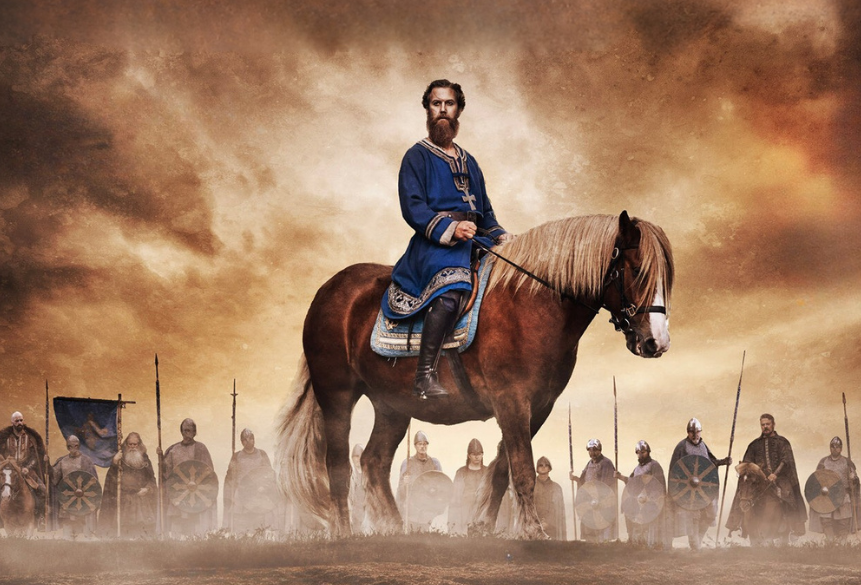The St. Olav Drama
This is the play of all plays in Norway. The Saint Olav Drama is performed every year at the end of July at Scandinavia’s largest open-air stage. The Saint Olav Drama is a dramatisation of the events that occurred just prior to the Battle of Stiklestad.

THE ST. OLAV DRAMA
For many people, Stiklestad is best known as the location where "The St Olav Drama" is performed during the Olsok days each year. From its inception in 1954, "The St. Olav Drama" has always been a collaboration between professionals and amateurs. "The St. Olav Drama" is referred to as “The mother of all dramas". In addition to the actors, musicians and singers a very large volunteer unit is needed, and "The St. Olav Drama" would not be possible without the enormous effort and high-quality engagement from hundreds of volunteers.
25., 26., 27. and 29. JULY 2023 19:00
Summary:
On the Sul farm, in the vicinity of Stiklestad, a family suddenly finds itself at the centre of cataclysmic events. A long and violent conflict over power and kingdom is about to reach its apex. The family´s religious beliefs, as well as the side they choose in the conflict, could mean the difference between life and death.
Torgeir Flekk, the farmer, and his wife Gudrid, are very fond of each other, but they carry a secret. Some years ago, Gudrid gave birth to a deformed child. In line with heathen practices, a servant on the farm, Grima, carried the child out into the forest to let it die. Gudrid believes that she had no other choice. Still, Torgeir, who has accepted the Christian faith, cannot bring himself to forgive his wife.
Gudrun, Torgeir and Gudrid´s daughter, was five years old when her sibling was born. The event has marked Gudrun for life, making her a restless child, who cannot bear conflicts. Her faithful helper when life becomes too hard is her grandfather Old Jostein, Torgeir’s blind father. Jostein knows that the only thing that calms Gudrun down is ancient legends and songs. However, reciting these is not without risk; the Christian king Olav has forbidden such heathen practises.
Rumours have reached Verdalen that king Olav Haraldsson is on his way back from Gardarike to regain the power he lost when he was forced to leave Norway two years ago. Many of the farmers are preparing to resist; they wish to protect the independence they have enjoyed during Olav´s absence. Gudrid’s brother-in-law, Torgeir Kvistad and his son, arrive at Sul to ask if they can expect Torgeir Flekk to join them against Olav. They inform him that Olav´s opponents have already gathered a large army and many ships. Even so, the farmer at Sul chooses to stand with Olav.
Tormod Kolbrunarskald arrives at Sul. He announces that king Olav and his men will arrive shortly and that they will have to spend the night there. Torgeir welcomes the news, but Gudrid claims that the king is an intruder. Olav arrives with his exhausted army. While they settle down, Arnljot Gelline, a chieftain from Jämtland, arrives and offers the king his support. Olav accepts on the condition that Arnljot accepts Christianity. The turmoil of the army´s arrival makes Gudrun uneasy. As usual, she begins to sing and dance to calm herself down. When the king notices this heathen practice he is furious and demands an explanation. He then learns the story of the dead child. Olav is initially enraged, but hearing the family´s pleads and seeing that Torgeir is a true Christian, he lets them keep the farm against a minor fee. Torgeir and his sons then pledge allegiance to the king and join his army.
Night falls and the army rests. At daybreak they break camp and leave Sul. Old Jostein follows them. Their journey will take them to Stiklestad where the farmers’ army awaits.
VIKING, SAINT AND SYMBOL
Olav Haraldsson was king of Norway from 1015. From a young age he went on Viking raids throughout Europe and he was baptized in Rouen in Normandy in 1014. He then returned to Norway where he reigned successfully for about a decade. However, from the mid-1020s Cnut the Great of the Danish/English kingdom managed to recruit many of Olav’s opponents and in 1028 the king had to flee the country.
Two years later Olav tried to regain his power, but instead, he was killed in the battle of Stiklestad on 29 July 1030. The following year, on 3 August 1031, he was canonized. From that day on he is known as St. Olav.
St. Olav quickly became the foremost symbol of church and monarchy in medieval Norway. He was often described as Rex Perpetuus Norvegiae, Norway´s eternal king and in the 13th century his axe became a central motive in the Norwegian coat of arms. Furthermore, St. Olav was a very popular saint, especially in Scandinavia, and the cathedral in Nidaros/Trondheim, with his shrine, became a desired destination for pilgrims.
During the thousand years that have passed since Olav´s death, numerous churches have been dedicated to St. Olav. The oldest one we know from written sources was erected in York in England in 1055, but there might have been an even older one in Orkney. In addition to this, numerous depictions of St. Olav can be found throughout both Europe and the rest of the world. The most exotic example is perhaps a portrayal on a column in the Church of the Nativity in Bethlehem, dated to ca 1160.